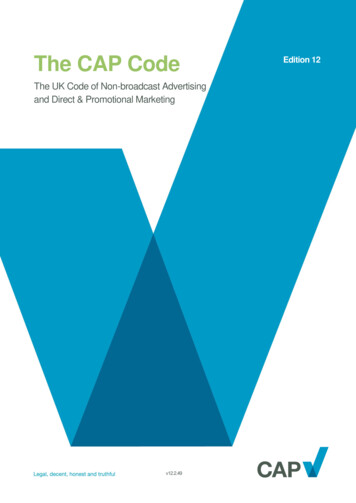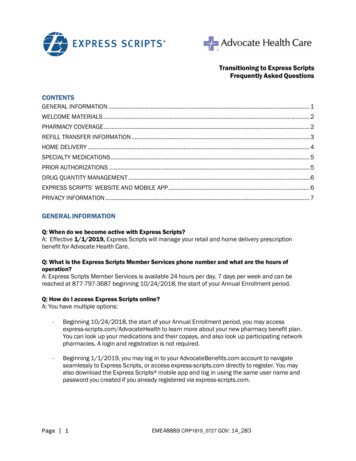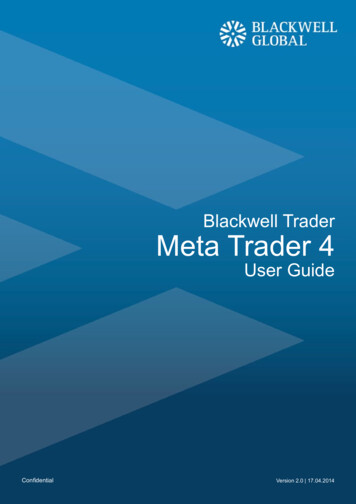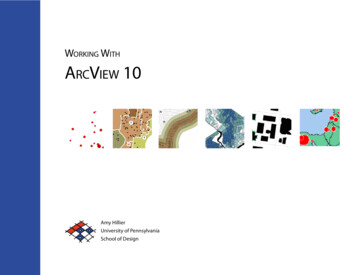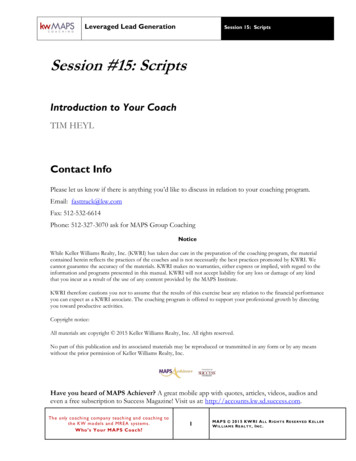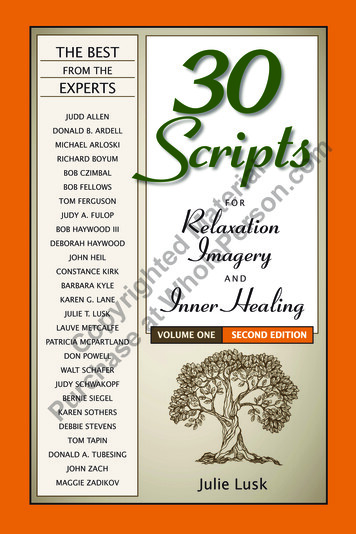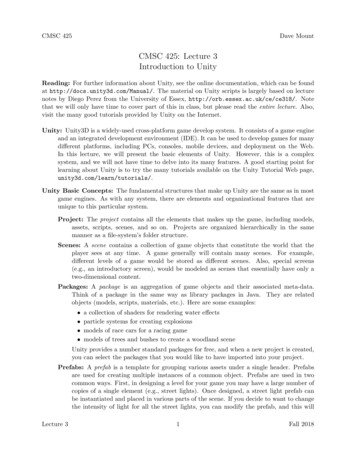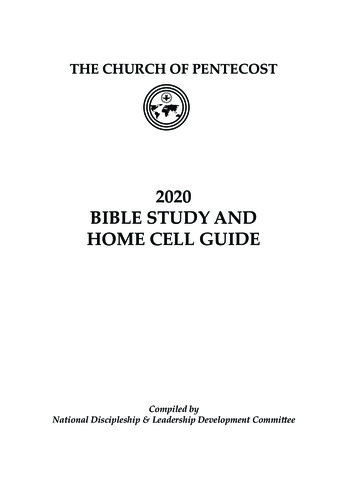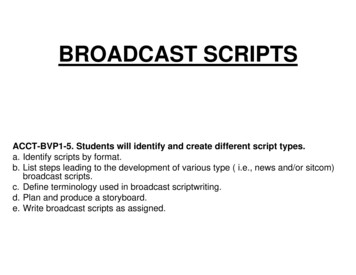
Transcription
BROADCAST SCRIPTSACCT-BVP1-5. Students will identify and create different script types.a. Identify scripts by format.b. List steps leading to the development of various type ( i.e., news and/or sitcom)broadcast scripts.c. Define terminology used in broadcast scriptwriting.d. Plan and produce a storyboard.e. Write broadcast scripts as assigned.
IntroductionToo many students experience anxiety when theyhear the word “writing.” One of the best things thatcan be said about television scriptwriting is that itbears little resemblance to the writing style requiredfor academic courses. Although scriptwriting isrelatively simple to do, good scriptwriting takes talentand skill
Program FormatsA script is an entire program committed to paper. It includes dialog, music, cameraangles, stage direction, camera direction, computer graphics (CG) notations, and allother items that the director or script writer feels should be noted.There are many different kinds of television programs, each with uniquerequirements of the script. Most programs fit into one of the following categories: Lecture. The lecture program format is the easiest format to shoot; the talentspeaks and the camera shoots almost entirely in a medium close-up. All that isneeded for this format is the talent, a camera, and a podium for the talent to standbehind. Other names for the lecture format are BTF (big talking face) or talkinghead. This format has the lowest viewer retention and is often the mark of anamateur. Lecture/Demonstration. The lecture/demonstration format lends itself to thenumerous cooking shows, how-to shows, and infomercials seen on television today.This format is more interesting to watch than a lecture alone because of the actionand many props used by the performers.
Program Formats Panel Discussion. The many Sunday morning network programs that bring agroup of professionals together to discuss current news and political topics areexamples of the panel discussion format. Also included are the popular daytime talkshows. These programs are not difficult to produce, as long as there is a limitednumber of people on the panel. Panel discussions are driven by the program’scontent, not action. As more people are added to a panel discussion, the shot toinclude all members gets rather wide. A wide shot is also a tall shot. This increasesthe risk of shooting off the top of the set. To keep the top of the set in the shot, thecamera may need to tilt down and inadvertently make the studio floor the mostprominent item in the picture. Interview. On location or in the studio, the two-person interview can be elcetifying.Peopl like Barbara Walters have build entire careers on making a simpleconversation a complelling program for the audience. The interview format is oftenshot with only one camera. To get various camera angle cuts between theinterviewer and the interviewee, the interviewee is shot for the entire duration of theinterview. The audio picks up the questions asked by the interviewer , but thecamera only shoots the interviewees' face. After interviewee has left the set, thecamera shoots the interviewer asking same questions a second time and recordssome nod shots.
Program FormatsNod shots are a special kind of cutaway The interviewer does not sty anything, butsimply “nods” naturally as if listening to the answer to a question. When collectingnody shots, the interviewer faces the direction where the interviewee was positionedduring the interview. In the editing room, the angles and not shots are cut togetherto create what looks like a conversation between the two people. Documentary. A documentary program is essentially a research paper fortelevision; the topic is researched, the information is outlined, and the script iswritten. The audio in a documentary may be either off-camera narration, or oncamera narration, or a combination of both. The audio portion f the script should beroughly written out before any shooting begins. In the process of writing, a shotsheet is develop. For a documentary program a shot sheet is like a grocery list ofshots needed to support the audio portion of the script. When shooting, the shots onthe list are captured. Additionally , the director watches for other shots that includespecific items, people, or anything that adds to the program's content and would beinteresting to the viewers. Shot sheets are only a guide and are rarely long enoughto provide enough footage to assemble an entire program. Always shoot morefootage than is listed on the shot sheet.
Program Formats Drama. This term includes both dramas and comedies. The drama format requiresa different kind of talent, actors. Actors take on a role in a program and perform assomeone or something other than themselves. Magazine. The magazine format originated from programs like “60 minutes,” buthas become more than news-oriented programming. A regular news broadcastpresents each story in two minutes or less. A magazine format program iscomprised of feature packages that address a single story. This allows moreinteresting detail to be included about each story, but fewer stories to be included ineach program. Music Video. The music video has become a common and influential force in ourculture. Items such as clothing shoes, fashion accessories, and hairstyles gainpopularity when seen in a music video. Music videos also serve to promote a bandor a new song or album, in the hopes of increasing the sales of CDs and concerttickets. Most music videos are one of three types:
Program Formats Concert Style. The audience sees the band perform the music that is heard.A concert style music video may include a compilation of different concerts theband has performed, a studio performance, or a various locations. Story Style. The audience hears the music, but never sees the band. Instead,actors act out a story line that is supported by the lyrics of the song. A hybrid of a concert style and a story style music video. When producing a music video, copyright permission is the first and foremostconsideration. Do not break the law! Public Service Announcement/Ad (PSA). Generally, Public ServiceAnnouncements/Ads are 30 or 60 seconds in length. The purpose of a PSA is toinform the public or to convince the public to do (or not to do) something in theinterest of common good. Anti-drug and anti-drinking and driving campaigns areexamples of PSAs. A typical television ad, on the other hand, attempts to convincethe public to purchase goods or services.
VisualizationVisualization is the ability to mentally picture the finished program. Visualizing aprogram is similar to daydreaming. The visualized details of a program should beput on paper, so that others can share the vision. Only when everyone, the crew ancast included, shares the vision for the program can it become a reality. GeorgeLucas waited to make The Phantom Menace, the fourth Star Wars film, untilcomputer graphics technology was sophisticated enough to realistically reproduceonto the screen the creatures and worlds he visualized in his mind.StoryboardsSome professionals use storyboards to help with visualization. Storyboardsresemble comic books, in that they present a sketch of the way image on televisionshould look. The disadvantage in using storyboards is the considerable time andtalent required to draw each scene. Storyboards do, however, offer an image of thescriptwriter’s vision to everyone who sees them.
The Program ProposalThe program proposal is created by the scriptwriter and provides general informationabout the program, including: The basic idea of the program. The applicable program format. The message to be imparted to the audience. The program’s intended audience. Budget considerations. Shooting location considerations. A rough program shooting schedule.The program proposal is presented to an executive producer for approval, either inwritten form or orally in a meeting. A program proposal is presented before writing afull script, to avoid waiting time and expense on a script that may be completelyrejected by the executive producer. The program proposal allows for an initial“green light” on the project.It is important to think through a script idea during the initial proposal stage. Usingvisualization, the scriptwriter can get a feel for the program and determine thedirection of the script. The executive producer may reject the proposal, accept it, orask for further details. Depending on the selected program format, the next stepmay vary.
ResearchBoth documentaries and interviews require that the program topic be researched.When interviewing someone, it is important to be proficient enough on the topic tohold a conversation that is interesting and informative. When developing a researchpaper, the research information is often organized on note cards. The notes arethen turned into individual paragraphs of the paper. In television, the individualparagraphs become scenes.The OutlineIf a program proposal is accepted, creating an outline is usually the next step. Alldramas, lectures, lecture/demonstrations, and documentaries use the same kind ofoutline. It is very brief, and not at all like the outline written for a research paper inschool. An outline includes comments, noting the direction of the program.In any of the formats described, the developed outline is submitted to the executiveproducer will either: Disapproves it. Tweaks the outline a bit. Gives suggestions to modify it. Approves it. - If approved, the next step is writing the actual script.
Drama OutlineThe OutlineAn outline for a drama breaks each major event in the story into the fewest numberof words possible and places each on a different line. It is a brief, chronologicallisting of the program's progression. The dialog is either nonexistent or minimal-justenough to relay the main point of each scene. The following is an outline for adrama called “Little Red Riding Hood.”House: Mom gives basket to LRR.Warns not to stray from path.Doorstep: Kiss goodbye, wave.Path: LRR walkingPath: Wolf sees LRR.Path: LRR walkingPath: Wolf running ahead to GM’s housePath: LRR walkingGM’s House: Wolf breaks in and eats GMGM’s House: LRR arrives and goes into bedroom.Bedroom: LRR and Wolf conversation “what big ”Bedroom: Wolf jumps up and chases LRR.Bedroom: Woodsman bursts in and kills wolf.Bedroom: Out pops GM.The end
The OutlinePanel Discussion or Interview OutlineThe outline for either an interview or panel discussion does not list major events orshow progression. In these outlines, the only necessity is a list of at least 20questions for the interviewee. Any question that can be answered in 10 words orless, with a number, or with a “yes/no” response does not count toward the 20questions minimum. Short answers make for an uninteresting program. Forexample, the question “How long have you been ?” is widely overusedon television. Unless the answer is unusual and sparks interest, viewers do not payattention to the answer. “How” (not “how long”) and “why” are the best kinds ofquestion-starters to use.Consider this: A 7-year old child who has just played a piano concerto at a majorconcert hall is asked how long he as been playing the piano. If the answer is “5years,” the question is worthwhile. However, if a 50-year-old man I asked the samequestion and he responds “30 years,” it is not particularly interesting.Every listed question may not be asked in the course of the interview or paneldiscussion program. A particularly interesting answer to a question may lead to animpromptu follow-up question. However, if the conversation lags, standby questionscan jump-start the conversation.
Music Video OutlineThe OutlineConcert style music videos do not require an outline. Only those with a story linecorresponding to the lyrics and music require an outline. The second step inproducing a music video may be to obtain copyright permissions or onceobtained, begin outlining and scripting. By this point, the executive producershould have heard the music and approved the quality and suitability of thelyrics. The lyrics of some songs are wholly inappropriate to be broadcast to thegeneral public.Expanding an OutlineOnce completed, it may be necessary to expand your outline to include more detailabout the program. To do is, take each line of the outline and list details relatedto that line. Much like the outline you would create for a research paper, listsub-topics and supporting details for each main topic line of the outline. Whenthe outline has been sufficiently expanded, it will be ready to go to script form.I.TopicA.B.II.Sub-topic1.Supporting detailSub-topic1.Supporting detail2.Supporting detail3.Supporting detailTopic IIA.Sub-topicB.Sub-topic1.Supporting detail2.Supporting detailC.Sub-topic1.Supporting detail
Writing the ScriptIt is recommended that all scripts be written using a computer word processingprogram. If written with a word-processing program and saved, any alterations andchanges requested by the executive producer or client are easily made withoutrewriting multiple pages of script.Consider This: Make sure to keep a copy of each revised version of scripts. Afteryour revisions are complete, do not simply press “Save.” Choose “Save As” andrename the file to reflect the revision sequence, such as “Scene 4 revision #3.”Otherwise, the previous version cannot be retrieved for future review or if a previousversion is preferred alter in the process.Unlike film scripts, television scripts are always written in two columns,. The leftcolumn is reserved for the video and technical information. The right column holdsthe audio and stage direction. The information in the right-hand column of atelevision script is exactly what is contained in a “play-style” script for a theatricalperformance.The right and left columns are not the same size. The video column is narrower thanthe audio column, taking only 1/3 of the page width. The audio column (rightc
A script is an entire program committed to paper. It includes dialog, music, camera angles, stage direction, camera direction, computer graphics (CG) notations, and all other items that the director or script writer feels should be noted. There are many different kinds of television programs, each with unique requirements of the script. Most programs fit into one of the following categories:

